
SETI@Home – Donate Your Computing Power to Search for ET
- By
- March 22, 2018
- September 28, 2021
- 16 min read
- 2
- Posted in
- Space, Future Exploration
If you are reading this, then the chances are you have at least a passing interest in alien life and what might lay out there in the infinite vastness of the cosmos. Furthermore, you very well might welcome the chance to join a global effort in the search for extra-terrestrial life – or at least the signals of it.

Is there life elsewhere in the Universe?
We have written before of the scientific, and widely accepted certainty of alien life elsewhere in the Universe. The thousands upon thousands of known galaxies and star systems, not to mention the infinite number unknown to us, all but guarantees this. However, once we speak about “intelligent life” – or at least intelligent in our understanding of the word – then the rules of the game change a little. Now we go from general indicators of a lifeform to very specific requirements that lead to an increased probability of intelligent life at least at a level to ourselves. The main thrust of this monitoring of the cosmos is SETI.
SETI’s main objective is to listen to the vast number of signals and radio waves coming at us from the deep reaches of space. The hope is, that an anomaly will show itself, which may, in turn, suggest purposeful electronic signals. This would likely make the source to be “intelligent” extra-terrestrial life. And depending on what is found in the signal, be a moment of great joy or great worry.
Contents
- 1 A Way To Involve Everyone!
- 2 Where, And Why It All Began
- 3 It’s Not An Offensive, We’re Just Listening!
- 4 The “Wow Signal!”, And Accusations Of Suppressed Data
- 5 A Global Effort, And The Seeds Of SETI At Home
- 6 How Does It work, And Why You Should Get Involved!
- 7 Not Rocket Science To Think Intelligent Life Exists Elsewhere?
- 8 Only A Matter Of Time!
- 9 A Radio That Listen To Everything, All The Time!
- 10 More Blurring Of The Line Between Science Fiction And Science Fact
- 11 Reasons Within Reasons!
- 12 How To Join
- 13 The Infinity Of Space – It’s Not Just For Beginners
- 14 William Herschel Discovers Uranus
- 15 The Double Discovery Of Alan Hale And Thomas Bopp
- 16 Amateur Footage Of “Incidents” On Jupiter
- 17 Discoveries Of Galaxies And Planets Far Away
- 18 Observed Space Phenomena
A Way To Involve Everyone!
SETI At Home gives every person who owns a computer the chance to join this all-inclusive effort from the comfort of their own home. Perhaps before you go ahead, maybe you would like to know a little more about SETI and what they aim to do. And, given some of the accusations of signals received being hidden from the public, why an ever-growing number of independent eyes on the cosmos might be key to revealing the answer to intelligent life elsewhere in the Universe.
If you’re not interested in reading the whole article and want to join in the search right away, you can do so by following the instructions here.
Where, And Why It All Began
As the 1950s were left behind and the hysteric-like approach to the vast amounts of “flying saucer” sightings began to calm somewhat, many people’s interest remained, but in a scientific capacity. With the space race providing a background of inevitability to humanity’s meeting with extra-terrestrials, some people began to think deeper than “little green men from Mars” in terms of the question of alien life.
One of first of these people was Frank Drake, who in 1960 at the National Radio Astronomy Observatory in Green Bank, West Virginia, would become the first astronomer to formally and purposely search the cosmos for extra-terrestrial life. His efforts would soon become SETI.
Part of their ideal was to bring a firm, scientific approach to the search for alien life. This would ultimately result in the “Drake Equation” – scientific reasoning why life on other planets very likely exists. The reasoning behind this lays in the details we take from observable space in our part of the universe, the Milky Way.
So, if the Milky Way is N, we have to take into account: the rate at which new stars are born each year (R)x, how many of these stars have planets (fp)x, and the average number of planets similar to Earth likely to support life (ne)x. We then need to decide the likely amount of those life-supporting planets where life does actually develop (fl)x, and then in turn what fraction of that life will be intelligent (fi)x, and further still, the amount of those intelligent civilizations that will develop such communication that can reach across the cosmos (fc)x. The average lifetime of such intelligent civilizations also needs to be factored in (L).
The equation itself is N = R X Fp X Ne X Fl X Fi X Fc X L

Radio telescopes monitoring signals from outer space
It’s Not An Offensive, We’re Just Listening!
The initial experiment by Drake in 1960 at Green Bank, West Virginia, went under the name ‘Project Ozma’. [1] Using an 85-foot diameter radio telescope, Drake would search the Tau Ceti, and Epsilon Eridani star systems for interstellar radio waves. Although he wouldn’t pick up any unusual signals to suggest alien life, it was an important first step in monitoring the universe.
Undeterred by this initial “failure” to locate anything of interest, he would gather some of the best, young scientists to join him. Throughout the decades, more and more likeminded scientists and astronomers would come together from across the planet. All looking for the same thing, and all in agreement, short of them “showing up on the White House lawn” that this was the best way to find it.
We as a collective send a whole array of signals into the cosmos every day and have done so electronically through radio waves and such in abundance since the early 1900s. Perhaps it is worth bearing in mind this very well may be a reason for the drastic increase in sightings from the mid-twentieth century onwards.
Although the deployment of nuclear bombs is often regarded as the reason for an increase in sightings (which themselves would send out energy waves into space), with the creation and mass distribution of radios and televisions, and more recently the Internet, more and more signals and masses of electronic information is heading out into the Universe.
As bizarre a notion as it is, anything from a commercial that ran in the Super Bowl, to the “I Have A Dream” speech by Martin Luther King could be the first data and ultimately, the first image an alien race has of humanity.
Sending signals out, however, is not the main drive of SETI.

Image of the Milky Way from the Earth
The “Wow Signal!”, And Accusations Of Suppressed Data
One of the few purposely designed communication signals sent out from Earth was in 1974. It left from the Arecibo Observatory in Puerto Rico. The message was named after the observatory and was designed by the aforementioned, Frank Drake.
The message was in binary form. It contained information about the human race, the population of the Earth, atomic and numerical systems, and even human DNA. The signals were sent towards the globular cluster M13 star system, which resides around 25,000 light years away.
Three years later, on 15th August 1977, at the SETI program at Ohio State University, Jerry R. Ehman would discover a very definite anomaly while monitoring narrowband radio signals from the cosmos. So strong and out of place was the signal that Ehman immediately circled them, writing the word “Wow!” next to them. He strongly suspected them to be non-terrestrial. In fact, they appeared to have come from the Sagittarius constellation.
Aside from the “Wow Signal” there has been no official reply or significant anomalies. However, a declassified NSA document, [2] “Key To The Extra-Terrestrial Messages” would raise an eyebrow or two in the conspiracy and UFO circles when it showed that twenty-nine “messages” had been received since the Arecibo message was sent into the cosmos. These “replies” were also in binary form. What they actually said, however, remains classified, if indeed a record even exists.
Incidentally, many were (and still are) critical of sending out such information out into the unknown. Such information as our genetic make-up and our location could be an invitation hostile aliens wouldn’t pass up. These claims are not simply made by conspiracy theorists either. Such highly respected thinkers as Stephen Hawking was one of the loudest voices on such topics.
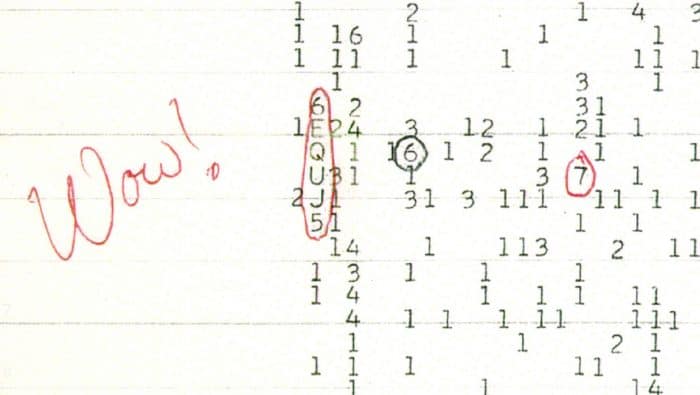
Image of the famous Wow! Signal
A Global Effort, And The Seeds Of SETI At Home
The recording of “Wow Signal” was the result of recruiting scientists and volunteers from all over the world. Anyone, who in the interests of perhaps making the greatest discovery in humanity’s history, would use their time to monitor the infinite reaches of space. The volunteer group at Ohio State University began their operations in 1973. They would remain on campus until 1997 when the university closed the radio telescope.
Other notable efforts include Project BETA, a privately funded project by The Planetary Society at Harvard University. Project BETA began operations in October 1995. What was an especially important capability of the BETA project was its use of two adjacent beams. These would allow “rapid and automatic re-observation of candidate signals”. BETA’s custom-built digital processing boards allowed it to receive 250 million channels at any one time. The project would come to an abrupt end, however, in 1999 when a storm caused damage to the radio telescope.
There continue to be global efforts to locate incoming signals that might indicate alien life. Significant operations continue today in Australia and Italy, for example. Many more small-scale efforts, however, usually by amateurs in science, astronomy, and radio technology, were taking place throughout the world.
As individuals, their contributions may prove to be valuable, but there was no consistent and concerted effort. In 1999, however, came one of the largest ever rollouts of computing software for the purposes of research. This would enable these amateur alien hunters to essentially join forces, not only with each other but with SETI themselves.
How Does It work, And Why You Should Get Involved!
For humans, be it through SETI or any other organization, to monitor the entire universe constantly would take a super-computer. And even then, it wouldn’t be enough in terms of power and data. However, the number of volunteers conducting their own smaller-scale study of the stars would present a solution. SETI proposed that many smaller computers, working at the same time, would overcome this problem.
All volunteers need to do is install a special screensaver and application (you don’t have to run the screensaver mode) on their computer. When the computer is not in use (or if wanted even when in use), this application will contact SETI. It then connects to its network, allowing SETI to utilize the processing power of the computer’s CPU and GPU (if available).
Through UFO Insight, you can be part of a team looking to assist in scanning the galaxy for signs, and indeed signals of intelligent life. Should your computer be the one that happens to pick up that second “Wow Signal!”, you are likely to be a part of a true turning point in human history.
You will also be able to keep up to date with the statistics and data produced by Team UFO Insight. In short, you would be part of, and contributing to the potential discovery of intelligent life beyond our planet.
One of the reasons the “Wow Signal” was ultimately dismissed was because it was a one-off and didn’t repeat itself. Imagine, if the amount of processing power was available back then through such projects as SETI At Home. Perhaps a repeat of that signal is found.
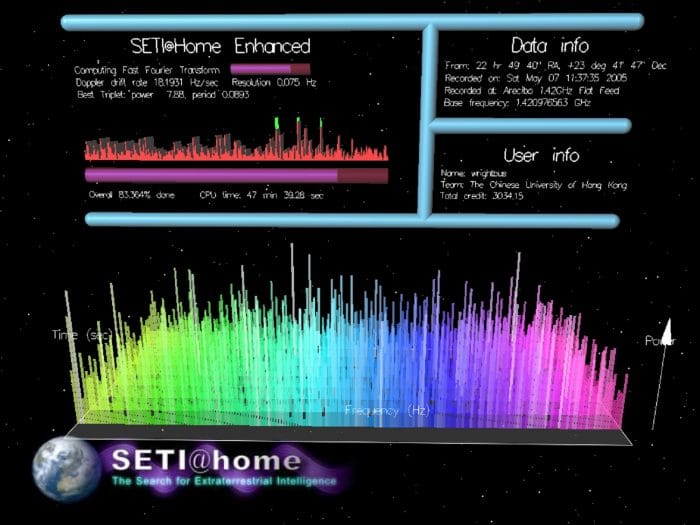
Image of the SETI at Home desktop
Not Rocket Science To Think Intelligent Life Exists Elsewhere?
OK, so how about a little bit of science and technology behind the mission statement. Without going to deep, the SETI team uses huge radio telescopes to constantly monitory the skies – and essentially, the Universe. What they are searching for as radio signals.
Just as many science fiction movies point to the cacophony of radio and television waves heading out into the Universe that an alien race, not always friendly, picks up and so pinpoints our location, so SETI is doing exactly that in an attempt to locate an intelligent form of life somewhere out there in the great beyond. Indeed, as is demonstrated on a regular basis, the program in itself is another example of science fiction becoming reality.

Image of stars and lights in space
And it isn’t, ironically enough, rocket science to come to the conclusion that due to the, literally, billions of stars out there, each of which will likely host multiple planets, the simple law of averages (itself universal) suggests it is a certainty that such intelligent life will exist on at least a small percent of these planets. Even if that was just one percent that is thousands of possible and even probable destinations for extraterrestrial life.
In fact, this universal thinking, that life simply must have developed, intellectually at least, in a very similar way elsewhere, that provides the basis for the rest of the SETI mission statement.
Only A Matter Of Time!
While life in terms of its appearance and development may indeed be drastically different elsewhere in the Universe, it is widely accepted that once a certain level of intelligence and developed technology is reached, that such things as radio waves would be utilized for much the same reasons as we use them. And it is this theory that SETI has based their program around. That the signals will most definitely be out there. Somewhere.
And just to demonstrate how many of these signals should be available from just one civilization, perhaps we should imagine the signals – and more specifically, their sources – that we send out into the far reaches of space every day.
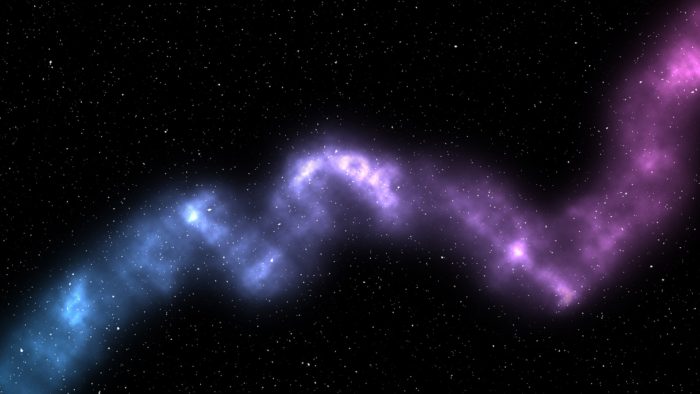
What might lie out there in the far reaches of the cosmos?
Everything from watching television (and imagine the absolute plethora of channels and waves from across the planet) these waves bounce around and out into space. As happens when we listen to the radio, use the Internet, even down to using your remote control on any number of seemingly trivial home appliances. Not to mention our ever-present mobile phones.
If aliens were looking for us, we have already given them a strong, steady, and persistent signal of our location.
With this in mind, then, we might think it would be ill-advised to send purposeful signals out into space. And some very serious-minded people have voiced such concerns. However, it is also a theory of some, that an intelligent race would also wish to broadcast its location, for the same reasons that we do. To find more life.
And, if those theories are correct, then “it is only a matter of time” before a signal from an intelligent form of life is detected.
A Radio That Listen To Everything, All The Time!
However, even for such a set-up as SETI, the computer power required is beyond comprehension for most of us. As SETI themselves state it would be like “having a radio that listen to every radio, TV, radar, satellite, and (even) garage door opener frequency all of the time”.
As another example, SETI states that their antennas records approximately 35GB of data per day. To appreciate how much this is, 35GB is around 140,000 work units. The average personal computer takes around 30 hours to process the information in one work unit. This means, just one days-worth of recording from a SETI antenna would take over 4 million hours to process using one system.
Could SETI purchase, install, and operate so many computers or the equivalent of? Quite possibly. Even so, it would be a huge financial drain, not to mention a huge consumer of time. Both of which would be surely better off actually continuing the search for extraterrestrial life as well as developing ways to detect it quickly.
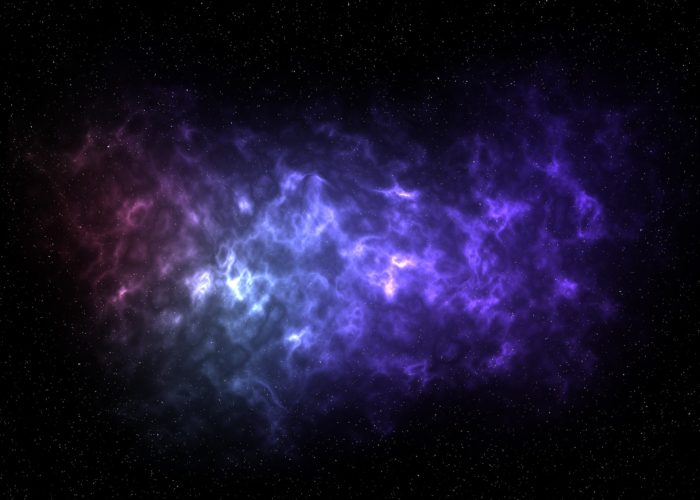
Will we find signals of alien life?
Hence, the SETI at Home program detailed above. A chance to not only roll out their technology in a huge way, but to involve all space and alien enthusiasts from all over the world. Whatever their interest and technical know-how, the SETI at Home program provides an opportunity for all of us to be part of something truly historic.
More Blurring Of The Line Between Science Fiction And Science Fact
And that, perhaps is one of the biggest draws to the SETI at Home program. You, or more to the point, your computer, will essentially become one of those SETI computers. An extension of the SETI search for extraterrestrial life. And the chances are, given the sheer amount of data that we have examined above that comes from the vast reaches of space daily, that the discovery, when it does happen, will come from the computer system of just such a volunteer SETI at Home user.
Indeed, one has images in one’s mind of a Hollywood blockbuster movie, with the initial discovery of alien life occurring on the computer of a typical teenager in the bedroom of their parents’ home. Once more, perhaps the ever-blurring line between science fiction and science fact will become a little more indistinguishable.
And while the discovery of such an intelligent life outside of our own might not come with huge motherships landing at major cities around the globe – certainly if such intelligent alien life was hostile this would be a good thing – the discovery will undoubtedly be one of the most exciting and life changing in humanities entire history. Even that still to come.
Of course, long before such programs as SETI, there is a rich history of discoveries in space made by “amateurs” here on Earth. Before we examine some of those, however, check out the video below. It examines once more as a reminder, just what SETI is all about. And below that is some further information regarding how to join the search for such alien life.
Reasons Within Reasons!
Even if the “Wow Signal” was a one-off, that should not make it irrelevant. As the Society for Planetary Defense would state, “…in 1974 our largest radio telescope in Arecibo Puerto Rico beamed out a powerful signal into the cosmos….and never repeated!” Perhaps that message was a response, or perhaps it was a civilization much like ourselves. One reaching out in a similar away to whoever might lay beyond their planet. Once only!
We have written several articles from an ancient astronaut perspective. Or at the possible reasons for many of the alien interactions with the human race. Although it isn’t part of the objective of SETI or SETI At Home, by finding intelligent alien life, it could reveal so much about the true history of humans on Earth, and possibly elsewhere.
Of course, having such an active involvement also makes you privy to any incoming signals. Perhaps the more of “us” that take part makes the concealment of such information more and more difficult.
Before you go ahead and join us, and SETI in the global search for intelligent life out there in the cosmos, perhaps it is worth reading the following from the SETI Institute’s website in 2010, “Today, we still strive to survive but now life has also reached the point where its exploration path has come to question its own origin. Indeed, we do explore to understand where we came from and define the meaning, if any, of this wonderful universal journey of ours. It is fascinating to realize how, as we walk the Earth, the surface of other planets, soon the Milky Way and beyond, that this journey gives greater depth to our consciousness, for exploration is also very much an inward voyage.”
How To Join
If you wish to join the official UFO Insight team and the search for alien life, all you have to do is:
- Go grab the client by clicking here. We’ll keep you posted on client updates. They’re working on ’em.
- Join the UFO Insight team here.
- Tell yourself that you rule. And that you will smash all the other members of Team UFO Insight on our team stats page.
The video below will also show you a little more about SETI At Home and the possibilities it brings.
The Infinity Of Space – It’s Not Just For Beginners
Although there are many organizations actively searching for alien life, perhaps in the driving seat is SETI and their SETI At Home program. While this is something that allows anyone and everyone with access to a computer the chance to join in the search for extra-terrestrial life, it isn’t the first time, for want of a better phrase, that amateurs have played a vital part in space exploration.
This is increasingly the case in the twenty-first century with the rapid progression and availability of technology. And the fact is professional astronomers and scientists whose work resides in the secrets of space generally accept this assistance gladly. With (relatively speaking) limited funds to investigate and monitor the vastness of the Universe, the help is required. Furthermore, any such assistance is a genuine contribution to humanity’s collective understanding of outer space.
William Herschel Discovers Uranus
It isn’t just in our modern era when amateur watchers of the stars made significant contributions to our collective knowledge of the cosmos. Although he would go down in history as a very respected astronomer, at the time William Herschel made his discovery of Uranus he was merely an amateur.
It was while working as a music director in the United Kingdom in 1781 that he made the historic discovery of a seventh planet in our solar system. At the time, it was the furthest known planet from Earth.
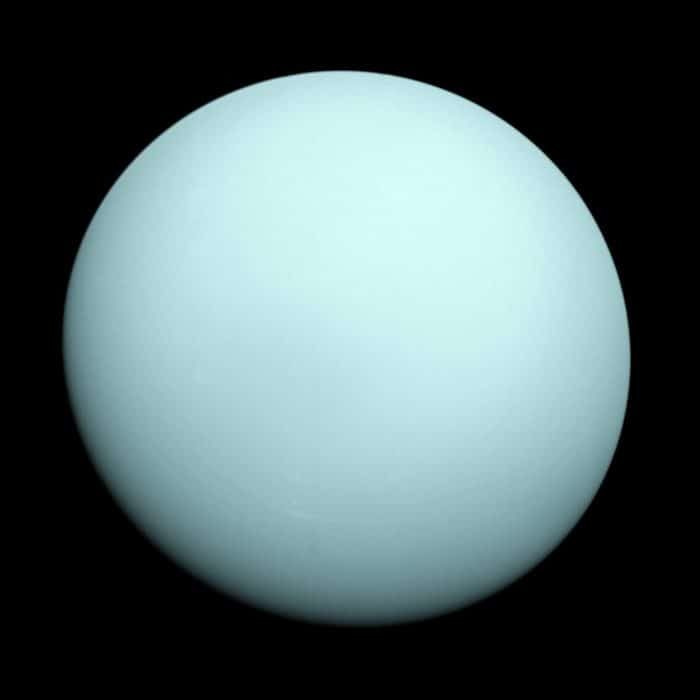
Close-up view of Uranus
The discovery itself was incidental to Herschel’s actual intentions of searching the cosmos for double star systems. He suddenly noticed a disk shape, but not one that shined as a star would. He at first thought the object may be a comet but he soon ruled this out due to the slowness with which it moved. In fact, it was moving so slow that Herschel soon suspected it had to be a heavenly body. One that was far from the sun. So far that it would lay beyond Saturn. He soon realized this “disk” was a new previously unknown planet.
Not only was it the first “new” planet in recorded history, it was first to be found that can’t be seen with the naked eye. Incidentally, Herschel’s intention was to name the planet “George” in tribute to the (then) King of England, George III. However, and possibly a consequence of his amateur status at the time, the new discovery was named after the father of Saturn, Uranus.
The Double Discovery Of Alan Hale And Thomas Bopp
A little over two centuries later, in 1995, two amateur astronomers would make a remarkable discovery of their own. Furthermore, each did so on his own accord and with no awareness of the other. Until they went public with their finds. From that point, their names, at least in cosmic terms, became linked forever.
On 23rd July, Alan Hale and Thomas Bopp set about watching the skies from their separate locations in New Mexico and Arizona respectively. Each was surveying the M70 globular cluster when both noticed something different from previous observations. When both men noticed that this strange new arrival was in yet another different location only hours later they realized it was a comet.
Both Hale and Bopp would submit their findings to the International Astronomical Union’s Central Bureau for Astronomical Telegrams. At the time, it was the furthest comet from Earth ever located and is known as the Hale-Bopp comet.
In March 1997, the Hale-Bopp comet passed through the inner solar system and at its closest point to Earth. Astronomers, both amateur and professional alike, marveled at the brightness of it. And would speculate of the complex make-up of its structure. It isn’t due to pass as close to Earth for approximately another 4,200 years.
Incidentally, the Hale-Bopp comet also shares one of darker stages of UFO history with the infamous “Heaven’s Gate” cult. According to their belief, a huge UFO mothership was following the Hale-Bopp comet. They believed by committing suicide they would be free of the “Earthly body” and be able to join their extra-terrestrial rescuers. Thirty-seven people died in total – twenty-one women and eighteen men – during the mass suicide in San Diego, California.
The video below features images of the Hale-Bopp Comet.
Amateur Footage Of “Incidents” On Jupiter
Given that it is the largest planet in the solar system, it is perhaps no surprise that many amateur discoveries are made regarding Jupiter.
In 2009, from his back garden in Canberra, Australia, and using a standard telescope, Anthony Wesley noticed an anomaly on the mammoth gas giant. [3] An “Earth-sized hole” appeared in the atmosphere of the planet. Wesley captured photographs of his find and sent them to NASA for further study. Although it isn’t certain, it would appear the “scar” was the result of a huge asteroid or comet.
Seven years later in 2016, two amateur astronomers managed to capture a cosmic event of Jupiter on video. Like Hale and Bopp, each was working independently to the other – from locations in Ireland and Austria. Each would upload their footage to YouTube, receiving much praise from professionals for their work.
The footage shows a mammoth object crashing into Jupiter. So large, that the resulting carnage was visible, albeit through a telescope, here on Earth. You can check out the footage below.
Discoveries Of Galaxies And Planets Far Away
Some discoveries by amateur astronomers go much further than our solar system. For example, in 2013 Michael Sidonio would discover an entirely new galaxy while photographing NGC 253. The discovery (NGC 253-dw2) came from the unlikely location of a farmer’s field, again in Canberra, Australia. What is particularly interesting about this newly discovered galaxy is it appears to be in the process of destruction. At the hands of its cosmic neighbor, no less. Now they are aware of its location, scientists will be able to study this process first-hand.
Only months previously in late-2012, Planet Hunters – an organization of amateur astronomers – declared their discovery of forty-two previously unknown planets. [4]
Furthermore, fifteen of these new cosmic bodies were in the “Goldilocks zone” of their stars. This means they could harbor or sustain life. It isn’t just the new planets that the amateur team has discovered that causes excitement. Many of the moons that orbit them may also prove to be of immense interest.
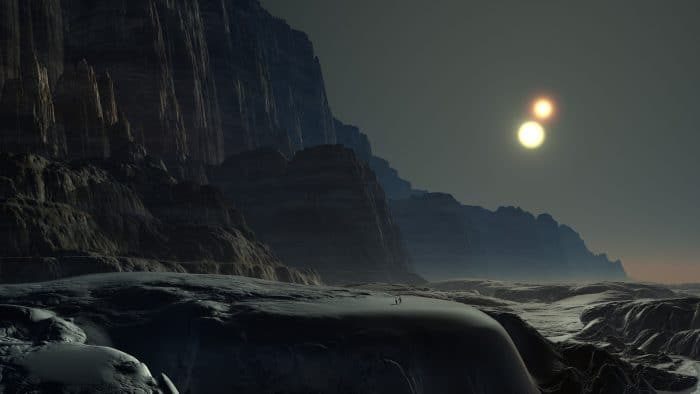
What might other planets look like?
Several months before Planet Hunter’s announcement was the discovery of a planet with two suns [5] by two of its members. Kian Jek and Robert Gagliano would make the discovery of this immensely interesting planet. Believed to be the size of Neptune its double-sun system is a fascinating one. NASA would even state it would force astronomers to rethink “accepted” knowledge of planet formation and behavior.
Observed Space Phenomena
There are also many other amateur discoveries of the bizarre and fascinating workings of the far reaches of space.
For example, in 2015, the Zooniverse Project would reveal information after studying images from NASA’s Spitzer telescope. They noticed the presence of “yellow balls” in many of these images, something apparently unseen by NASA themselves. NASA would investigate the information reaching a fascinating conclusion. According to their research, these balls were actually the very early stages of stars forming. They would describe the discovery as “ground-breaking”, with others referring to it as an astronomy version of the missing link.
Shortly after this announcement, on Christmas Day 2015, Emmanuel Conseil would literally discover a new star. Furthermore, due to his monitoring this location for several days previously, he knew the star was in the first hours of its life. There were no indications of its presence even the previous day. The discovery received a reasonable amount of media coverage. So much so, it was loosely named the “Christmas Star” for obvious reasons.
There is no doubt that amateur astronomers will continue to play a vital role in humanity’s search for knowledge of the cosmos. And as much as space is infinite so are the possibilities of what new discoveries await us.
The video below looks at some of the most remarkable mysteries of the Universe.
References
| ↑1 | Project Ozma, SETI https://www.seti.org/project-ozma |
|---|---|
| ↑2 | Declassified NSA Document Reads: “Key To The Extraterrestrial Messages”, Arjun Walia, Collective Evolution, July 17th, 2013 https://www.collective-evolution.com/2013/07/17/unclassified-nsa-document-reads-key-to-the-extraterrestrial-messages/ |
| ↑3 | Amateur astronomer spots Earth-size scar on Jupiter, Toni O’Loughlin, The Guardian, July 21st, 2009 https://www.theguardian.com/science/2009/jul/21/jupiter-scar-comet-asteroid-crash |
| ↑4 | 42 Alien Planets Discovered By Amateur Astronomer Group, Eric Brown, International Business Times, January 12th, 2013 https://www.ibtimes.com/42-alien-planets-discovered-amateur-astronomer-group-1011168 |
| ↑5 | Amateur Team Finds ‘Tatooine’ Planet with 2 Suns in 4-Star System, Jeanna Bryner, Space, October 15th, 2002 https://www.space.com/18065-alien-planet-tatooine-twin-suns-stars.html |
Fact Checking/Disclaimer
The stories, accounts, and discussions in this article may go against currently accepted science and common beliefs. The details included in the article are based on the reports, accounts and documentation available as provided by witnesses and publications - sources/references are published above.
We do not aim to prove nor disprove any of the theories, cases, or reports. You should read this article with an open mind and come to a conclusion yourself. Our motto always is, "you make up your own mind". Read more about how we fact-check content here.
Copyright & Republishing Policy
The entire article and the contents within are published by, wholly-owned and copyright of UFO Insight. The author does not own the rights to this content.
You may republish short quotes from this article with a reference back to the original UFO Insight article here as the source. You may not republish the article in its entirety.




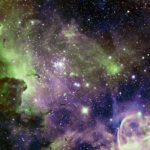
2 Comments
UFO Insight does not take responsibility for the content of the comments below. We take care of filtering profanity as much as we can. The opinions and discussion in the comments below are not the views of UFO Insight, they are the views of the individual posting the comment.
Newest comments appear first, oldest at the bottom. Post a new comment!
I was supporting SETI @ Home 20 years ago,
I sent back the computed items,
I think that it was good to participate at that time.
It is a wonderful attempt and achievement.
Since you know how to support Seti you should continue. I don’t know how unfortunately I saw a ship in the mid 60’s and will never forget it. It was. So close that if i had been standing on the gauge roof i could have touched it